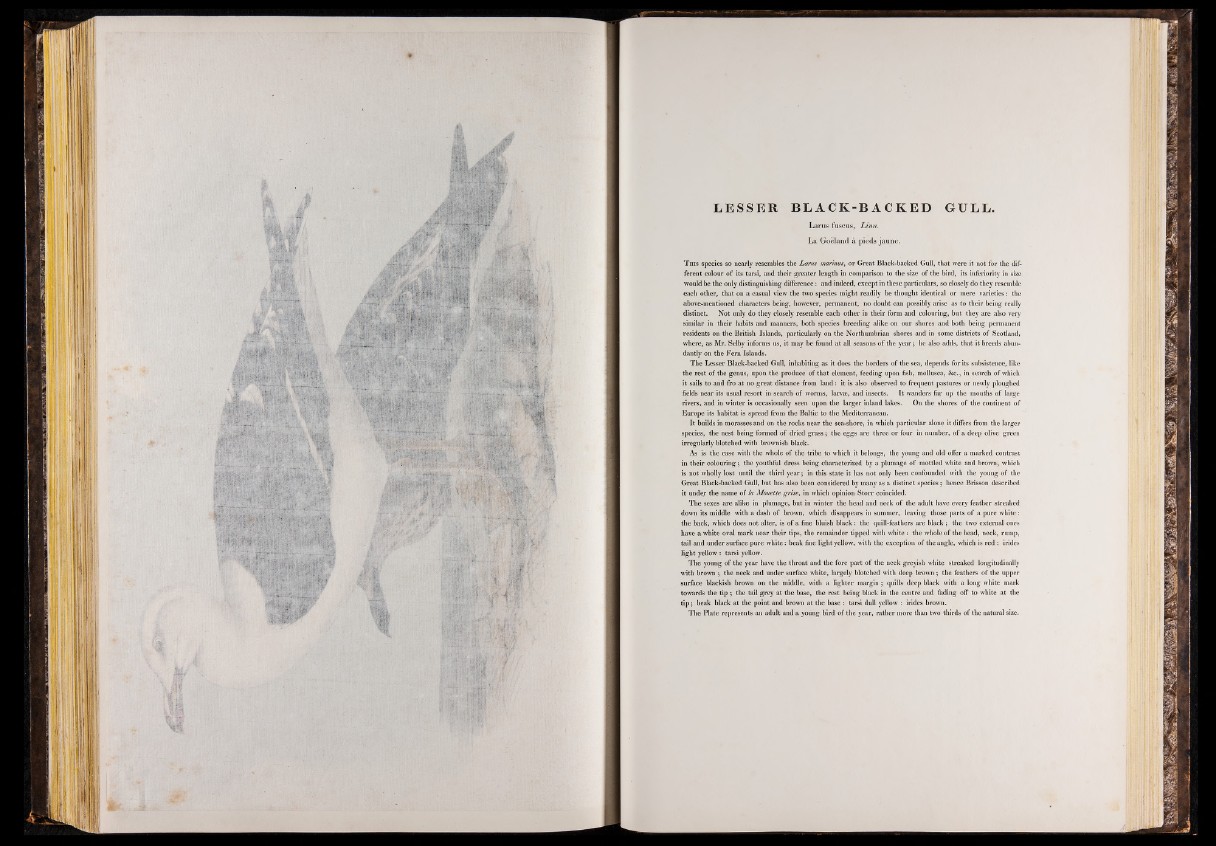
.M i .
'IKK:
SfeflNSM
i nII
M i l
» . 1 * 8 1 SIB,Si
S ® î ! É :‘
l i f B . f i ■ S
i i i l , l a
f B W " - • -
É®
I
••til
L E S SE R B L A C K - B A C K E D GULL.
Larus fuscus, L in n .
La Goéland à pieds jaune.
T his species so nearly resembles the Larus marinus, or Great Black-backed Gull, that were it not for the different
colour of its tarsi, and their greater length in comparison to the size of the bird, its inferiority in size
would be the only distinguishing difference : and indeed, except in these particulars, so closely do they resemble
each other, that on a casual view the two species might readily be thought identical or mere varieties : the
above-mentioned characters being, however, permanent, no doubt can possibly arise as to their being really
distinct. Not only do they closely resemble each other in their form and colouring, but they are also very
similar in their habits and manners, both species breeding alike on our shores and both being permanent
residents on the British Islands, particularly on the Northumbrian shores and in some districts of Scotland,
where, as Mr. Selby informs us, it may be found at all seasons of the year ; he also adds, that it breeds abundantly
on the Fern Islands.
The Lesser Black-backed Gull, inhabiting as it does the borders of the sea, depends for its subsistence, like
the rest of the genus, upon the produce of that element, feeding upon fish, mollusca, &c., in search of which
it sails to and fro at no great distance from land : it is also observed to frequent pastures or newly ploughed
fields near its usual resort in search of worms, larvæ, and insects. It wanders far up the mouths of large
rivers, and in winter is occasionally seen upon the larger inland lakes. On the shores of the continent of
Europe its habitat is spread from the Baltic to the Mediterranean.
It builds in morasses and on the rocks near the sea-shore, in which particular alone it differs from the larger
species, the nest being formed of dried grass ; the eggs are three or four in number, of a deep olive green
irregularly blotched with brownish black.
As is the case with the whole of the tribe to which it belongs, the young and old offer a marked contrast
in their colouring ; the youthful dress being characterized by a plumage of mottled white and brown, which
is not wholly lost until the third year ; in this state it has not only been confounded with the young of the
Great Black-backed Gull, but has also been considered by many as a distinct species ; hence Brisson described
it unde.r the name of la Mouette grise, in which opinion Storr coincided.
The sexes are alike in plumage, but in winter the head and neck of the adult have every feather streaked
down its middle with a dash of brown, which disappears in summer, leaving those parts of a pure white :
the back, which does not alter, is of a fine bluish black : the quill-feathers are black ; the two external ones
have a white oval mark near their tips, the remainder tipped with white : the whole of the head, neck, rump,
tail and under surface pure white : beak fine light yellow, with the exception of the angle, which is red : irides
light yellow : tarsi yellow.
The young of the year have the throat and the fore part of the neck greyish white streaked longitudinally
with brown ; the neck and under surface white, largely blotched with deep brown ; the feathers of the upper
surface blackish brown on the middle, with a lighter margin ; quills deep black with a long white mark
towards the tip ; the tail grey at the base, the rest being black in the centre and fading off to white at the
tip ; beak black at the point and brown at the base : tarsi dull yellow : irides brown.
The Plate represents an adult and a young bird of the year, rather more than two thirds of the natural size.